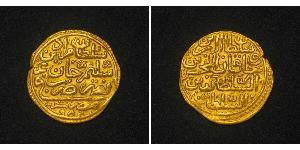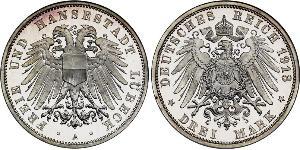(sold for $115.0)
1189, Normans in Sicily, William II. Rare Gold Tari (d'oro) Coin. 1.51gm!
Reference: Spahr 106. Denomination: Gold Tari Mint Period: 1169-1189 AD Mint Place: Messina or Palermo Condition: Weakly struck area due to a typically irregular cob-like planchet, otherwise XF! Diameter: 15mm Weight: 1.51gm Material: Gold!
Obverse: Long-cross, flanked by Christogramm (IC-XC = "Jesus Christ" / NI-KA = "Conquers"). Two pellets in upper fileds. Legend: IC-XC / NI-KA
Reverse: Arabic legend around uncertain object within circle
William II (French language: Guillaume II; 1155 – 11 November 1189), called the Good, was king of Sicily from 1166 to 1189.
William was only eleven years old at the death of his father William I, when he was placed under the regency of his mother, Margaret of Navarre. Until the king was declared adult in 1171 the government was controlled first by the chancellor Stephen du Perche, cousin of Margaret (1166–1168), and then by Walter Ophamil, archbishop of Palermo, and Matthew of Ajello, the vice-chancellor.
William's character is very indistinct. Lacking in military enterprise, secluded and pleasure-loving, he seldom emerged from his palace life at Palermo. Yet his reign is marked by an ambitious foreign policy and a vigorous diplomacy. Champion of the papacy and in secret league with the Lombard cities he was able to defy the common enemy, Frederick I Barbarossa. In 1174 and 1175 he made treaties with Genoa and Venice and his marriage in February 1177 with Joan, daughter of Henry II of England and Eleanor of Aquitaine, marks his high position in European politics.
In July 1177, he sent a delegation of Archbishop Romuald of Salerno and Count Roger of Andria to sign the Treaty of Venice with the emperor. To secure the peace, he sanctioned the marriage of his aunt Constance, daughter of Roger II, with Frederick's son Henry, afterwards the emperor Henry VI, causing a general oath to be taken to her as his successor in case of his death without heirs. This step, fatal to the Norman kingdom, was possibly taken that William might devote himself to foreign conquests.
Unable to revive the African dominion, William directed his attack on Egypt, from which Saladin threatened the Latin kingdom of Jerusalem. In July 1174, 50,000 men were landed before Alexandria, but Saladin's arrival forced the Sicilians to re-embark in disorder. A better prospect opened in the confusion in Byzantine affairs which followed the death of Manuel Comnenus (1180), and William took up the old design and feud against Constantinople. Durrës was captured (11 June 1185). Afterwards while the army (80,000 men including 5,000 knights) marched upon Thessalonica, the fleet (200 ships) sailed towards the same target capturing on their way the Ionian islands of Corfu, Cephalonia, Ithaca and Zakynthos. In August Thessalonica fell to the joint attack of the Sicilian fleet and army and was subsequently sacked (7,000 Greeks died).
The troops then marched upon the capital, but the army of the emperor Isaac Angelus defeated the invaders on the banks of the Strymon (7 September 1185). Thessalonica was at once abandoned and in 1189 William made peace with Isaac, abandoning all the conquests. He was now planning to induce the crusading armies of the West to pass through his territories, and seemed about to play a leading part in the Third Crusade. His admiral Margarito, a naval genius equal to George of Antioch, with 60 vessels kept the eastern Mediterranean open for the Franks, and forced the all-victorious Saladin to retire from before Tripoli in the spring of 1188.
In November 1189 William died at Palermo, leaving no children. Though Orderic Vitalis records a (presumably short-lived) son in 1181: Bohemond, Duke of Apulia. His title of "the Good" is due perhaps less to his character than to the cessation of internal troubles in his reign.
Only 1$ shipping for each additional item purchased!

|
Posted by:
anonymous 2017-02-06 |
3 Mark Free City of Lübeck Silver
group has 73 coins / 72 prices
⇑























